RG on Benchmarking, meeting with Gottfredson Update, 11/10/13: Back in August the Register Guard editorial board took a look at Michael Gottfredson’s first year as UO president. They weren’t impressed:
… And if a president proves lacking in either vision of his own or the ability to execute the vision of others, the board can replace him.
Gottfredson’s response to this new arrangement — he’ll be liberated in some ways, more accountable in others — will be telling. The board will expect, even demand, that he become more vocal in articulating the university’s mission, and leave behind the caution that can characterize presidents who are in some respects mid-level state bureaucrats. …
Today they take another look, after meeting with him Tuesday, just before he flew south to catch the football game with Stanford. Today’s RG editorial mostly focuses on the benchmarking data from Interim Provost Scott Coltrane, and data from the AAUP national union’s Howard Bunsis. Showing under-investment in faculty. Gottfredson does get a shout-out at the end, but there’s no evidence the editors think he’s broken out of that mid-level bureaucrat mode:
Low per-student spending is reflected in many of the other benchmarks. In 2010-11, the UO had the highest ratio of students per tenured or tenure-track faculty member — 35 to 1. The average at other AAU public universities was 23 to 1.
Five years earlier, the UO’s ratio of tenure-related faculty to students was 32 to 1. The university saw a 20 percent surge in student enrollment during that period, and almost managed to keep pace with a 19 percent increase in the total number of faculty. Nearly all of the increase, however, was among lower-ranked faculty with smaller paychecks and less job security. The UO kept professors in front of its students by watering the soup.
This conclusion is buttressed by an analysis presented in March by Howard Bunsis, a professor of accounting at Eastern Michigan University and chairman of the American Association of University Professors’ Collective Bargaining Congress. Bunsis found that from 2005 through 2012, the number of part-time faculty at the UO rose 38 percent, while full-time faculty increased by 1 percent. Bunsis also found that among nine AAU public universities, faculty salaries at the UO ranked last — except for instructors, the lowest rank examined, whose salaries ranked fifth.
We’d know more, but Gottfredson hasn’t released the performance review OUS did on him this spring, and 15 months into the job UO doesn’t even have the beginnings of a plan to deal with its problems. The early RG story on the meeting quoted him as saying:
The university increased its faculty ranks by about 20 this fall to address the problem, but it would need about 100 additional faculty to keep up with the enrollment growth of recent years, Gottfredson said.
“That’s probably our near-term target,” he said.
Probably? What fields? What’s the strategic emphasis? How are you going to reallocate funds? Not very inspirational, or even very organized.
UO releases chilling benchmarking report:
- Oregonian reporter Betsy Hammond quotes from Provost Coltrane, not President Gottfredson, taking the credit for releasing this report. So where’s our President? On his way to a football game, of course. We are so screwed.
- RG reporter Diane Dietz gets some Gottfredson quotes, from his talk to the RG editorial board. He sounds sleepy.
- University cancels former Provost’s lucrative 2 year salary, for unspecified transitional administrative job. No, of course I’m not talking about UO’s Jim Bean. This was at NC State. Despite all UO’s financial troubles, Gottfredson is going to give Bean another $500K for an administrative sinecure.
11/4/2013: The first step is admitting you have a problem. UO has now done this, sort of, with this public “benchmarking report”, posted here. Produced by Academic Analytics, it lays out a plethora of problems, in admirably blunt graphs. The report was posted today on Provost Coltrane’s academic plan website, here. UO paid quite a lot for this info – here are just some of our consulting expenditures over the past year:
This benchmarking effort is part of the secretive strategic plan that President Gottfredson will presumably be discussing with the RG editorial board, this Tuesday at 1:00. So far the UO Senate hasn’t heard a word about this report, or had any input into the development of a financial plan to address these issues. The Senate Budget Committee hasn’t even met this year. Gottfredson won’t even show the faculty UO’s budget projections, which were part of his secret performance review by OUS this spring:
The benchmarking report does not include any of the sort of skeptical inquiry into UO’s priorities and spending that can be found in the faculty union’s Bunsis Report, here.
Research funding, research output per professor, student SATs, graduation rates, PhD production. You name it, we’re at the bottom or close to it. Here’s my look at the report. The takeaway? This is more transparency than we’ve ever before had from Gottfredson, but the report is slanted so as to make the UO faculty look bad, and it omits important data about UO’s spending and donations.
Undergrads:
Careful with this one, it’s got a truncated y-axis:
On the PhD side though, things are grim:
However these data combine giving to academics and to athletics. VP for Development Mike Andreasen has an aspirational goal of raising the academic sides take to 2/3 of the total – but the athletic department won’t cooperate with his fundraising efforts:
Q: what’s the downside to taxing the athletic donations? This last year, a 5% tax would have brought $5-6M to academics. What’s the downside? Would it hurt the core mission of teaching/research side to lose some athletic donations?
Mike Andreasen: People aren’t inspired by this sort of tax or fee. The idea is to get them excited about the UO, then inspire them to give to the academic side. We don’t want to turn off the athletic donor who might become an academic donor.
Comment: Don’t call it a fee or tax, call it an opportunity to help the students.
Mike: we’re building relationships with these people. If a donor doesn’t want to give to something, we don’t want to be in a position to turn down the gift or to aggravate them. We want to get them excited about giving.
Q: What’s your strategy to get academic donations to be a larger percentage?
Mike:
Q: If we assume that most of the big donors give to athletics, it would require a big shift in culture or donor demographics of donors.
Mike: Most of the big donors are to academics. Most schools have one or two big athletic donors. Most of the athletic donors are small donors – people who donate just so that they can get tickets to the games, and they’re not interested in giving anything else to UO.
The UO Foundation has data on the split – is it possible they won’t release them to the UO President? They won’t tell the CAE much – but what they do reveal suggests that giving to UO academic causes is pretty small:

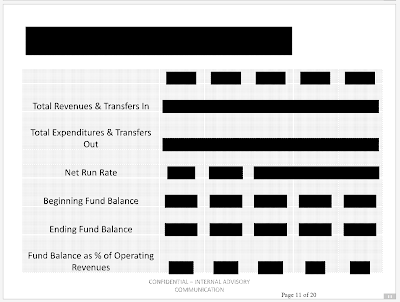





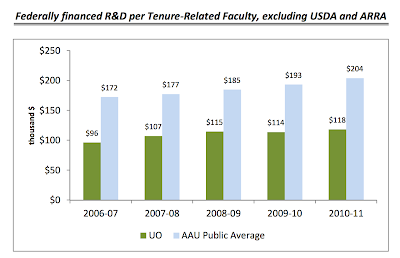

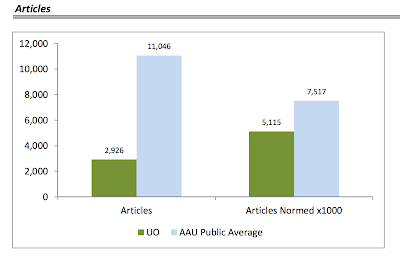

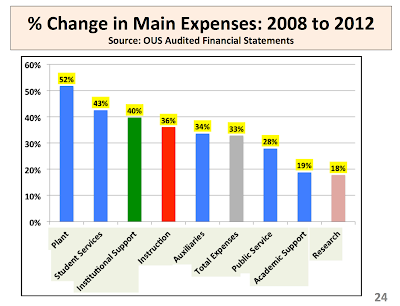



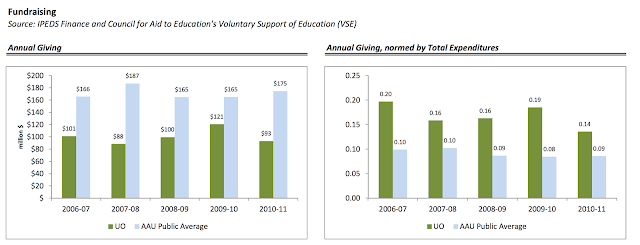


Notice they discuss spending per student FTE, not faculty salaries, because as Rudnick pointed out the AAU is not the right comparison for salaries.
1. The faculty would look a lot better if the UO took counter offers seriously. As it is, the shit wages allow people to be tempted by outside offers, and the shitty counteroffers make it easy to say yes, even when folks love the UO and would prefer to stay.
2. I would think the lack of engineering and medical schools hurts the number of pub and citation measures because we know both of those fields put 10-15 people on papers that are 3-6 pages long.
3. Investigating in fields like public health might be a good strategic direction because there is plenty of grant funding and publishing in public health journals is super easy.
RE: public health……..ORI has that market cornered already. UO can’t compete with that.
From the sciences- our research costs are very high here and it’s hard to afford large research groups, which results in lower productivity and lower PhD numbers. We pay full graduate tuition off of grants, an unusual situation especially for public universities. The CA schools have tuition waivers after students advance to candidacy. Research facilities costs here are high. Postdocs are expensive because of the benefits. So an average NSF grant funds less research here.
I suppose these weird price incentives would be ok if they gave the tuition back to you in additional central dollars supporting you. However, that seems to not be the case, as central admin research support is critically low. Waiving tuition for grad students, especially after advancing to candidacy seems like a no brainer, unless their intention is to tax science research to fund something else.
Strongly agreed. A grant supports considerably less at UO than it does at other places, and since productivity leads to future grants, there’s a vicious feedback loop.
At UO, we have the bizarre situation that PIs need to pay into retirement benefits on postdocs salaries, even though postdocs can’t receive the benefits! So a postdoc getting a salary of $42k costs a grant about $90k or more ($42k x 1.5 for benefits x 1.43 for overhead = $90,000). When I asked, the bizarre response is that we are paying into the “benefit pool,” essentially taxing the pay on temporary employees (3 year postdocs) to fund others. This is nuts. I don’t know of any other university where a postdoc costs $90k. It’s so obviously nuts that it was widely rumored that the university was going to finally stop it, until the union’s bizarre categorization of postdocs being somehow the same as faculty put an end to this hope. The only way I can make sense of all this is to make up weird conspiracies. For example: the administration believes that there are too many postdocs in the US, which is true and the topic of lots of discussion, and is _secretly_ adopting strategies to _locally_ fight these broader trends by making postdocs difficult to hire. Got anything better?
And graduate tuition: I was surprised to learn that Oregon doesn’t grant tuition waivers to advanced graduate students. Another high cost on grants.
More positively: if we want to increase research productivity, graduate degrees, …, there are easy paths to this. If we don’t, we should just say so.
My understanding is that all public employees at .5FTE and above must pay into PERS. How could the university have “fixed” this?
Also, I don’t think it’s correct that postdocs can’t receive benefits. As long as they choose ORP instead of PERS, they will get the money in a Fidelity or TIAA-CREF account that they can take anywhere. This happened to me when I was a postdoc at Texas, and the money that was paid into my TIAA-CREF account there got rolled into my TIAA-CREF account here.
Dog says,
if your 100% supported on a Federal Grant as a post-doc why are you then a public employee of the
State of Oregon?. OSU has managed to get around this, precisely because your not technically a
state employee. Other universities have done similar. We have not. Name your reasons.
As Oryx notes, there was indeed a UO plan in motion to create postdoc positions exactly as at Oregon State. It was working its way through relevant offices when the union was voted in. At issue is a 5-year vesting for employer contributions to ORP. Since postdocs are designed to be shorter-term <5 year positions, this is money just lost from grants. Re anon above, Texas ORP vesting times are just 1 year.
Also maybe we could get some research published if we had smaller or fewer classes, more graduate students (as RA’s rather than GTFs), and had better start up packages.
Am I missing anything??
So, if you didn’t have to pay your graduate students as much and you had less teaching to do, you could get some researched published. Is that the long and short of it?
It’s the grad tuition, not their actual pay. Nobody wants to cut graduate student pay or benefits! They never see the tuition. And it’s about MORE publications. We already do quite a bit given the constraints.
No actually I am publishing quite well and recently got an outside offer at an IVY. Just imagine what I could do with some RAs and better start up funds….
To “So, if …” I can verify that “Also maybe ” is indeed publishing well and does indeed have an offer from an ivy league school.
Post your email and I’ll send you my offer letter and CV.
Maybe it would be a good time for a public discussion? You could send the offer letter and CV to [email protected]
Great idea!
If junior, I would only talk of the record. There is no trust between faculty and the UO admins. We need senior people to share the details.
Thanks, UOM, for the shout-out to UO’s liberal arts faculty–who churn out books prodigiously with relatively heavy teaching loads and next to no research support from central admin.
My guess is that whatever grand plan JH unveils will continue to take unsung, unremunerated advantage of them (go union!0, while flailing stupidly & throwing money at something else.
But how are their books rated on amazon relative to AAU comparators?
I bet UOM made up all these embarrassing statistics. It’s all part of his long game… the persistent take down of all things UO, because, you know, he doesn’t care at all.
No administrators are to blame at all. Gottfredson and Bean and did everything they could to save campus, but were stymied at every turn… by UOM, of course.
We’re doomed, especially given that we’re one of the world’s best public institutions ever conceived by mankind. (Keep saying it, Gottfredson. I believe you now that I see UOM’s false numbers. They are so bad that the truth must be awesome!!!)
Glad to see you’re getting the message. We’ll turn down the mic a bit now.
Dog says
Our PHD production rate, in terms of percentage of all degrees awarded on FY basis, has been at
the bottom of the AAU for at least a dozen years. In FY 2013 this percentage was 1.98% and has
generally stayed in the range of 2-3% since 2000. The next closest in the AAU is about 6% – a typical
research University is 12-15%. In my view, this is has been the longest structural problem at the UO, i.e.
lack of PHD students at relevant scale, that has gone unaddressed and I think has mostly been ignored.
As a consequence we remain in this strong, rate-limiting, negative feedback loop.
How strange, this report has no data on the productivity or cost of UO’s central administration.
I tried to do a cost/benefit ratio for JH, but Mathematica keeps giving a “divide by zero” error.
This is the public report. They’re sitting on the really bad stuff.
Dog says
I am not sure what the “really bad stuff” is. To me the reports is transparent. The UO is fundamentally
an increasingly undergraduate institution with continued disinvestment in instruction and research. I
regard that, as “really bad stuff”.
Agreed. And yet, something tells me there’s even more.
Just look at research computing on campus. Three year old system with no plans to upgrade or replace. Research is shit here, and I watch students leave for better opportunities elsewhere (.edu and .com). Forget academics like myself, many of us are here to stay. We’re starving for good graduate students.
I don’t know about you guys, but I’m excited. They wouldn’t let this news out, unless they were planning on spending/raising some money. So I am anticipating new buildings, new colleagues, more grad students, smaller classes. All this was terrible news, I am anticipating the best news is around the corner.
Basically, we found another well and it ain’t dry!!!!
While I applaud your enthusiasm. I’m sure I don’t need to post what will happen next after this supposed fact finding report launched for the benefit of the new, private board.
Sure, let’s raise $200 million to expand the football stadium, which will help us get a permanent top BCS ranking, which will help us recruit more out of state and international students, which will solve all of our problems by [mumble mumble]… PROFIT!
Bingo! But, don’t forget the indoor track.
And then there are the campus program cuts. Or maybe we should call them ‘program refinements’ where students and faculty can embrace new tech, forward thinking and participate through the sustainability of online courses from the comfort of their expensive, new student housing. Some faculty will lose jobs, but hey … sorry.
My challenge to Gottfredson and Coltrane, prove the optimists around here right for once.
Stadium expansion will not help us recruit students. If Rodger Thompson say it will, laugh in his face.
Gottfredson should stay in Palo Alto. Coltrane will make a better president anyway.
The president role is now *totally* about fundraising. It doesn’t matter who it is.
btw … have I mentioned “Being There” ?
At least we have this as a recruiting tool… http://knowmore.washingtonpost.com/2013/11/06/what-america-will-look-like-once-global-warming-melts-the-polar-ice-caps/
Although, I have heard that the AD is tempting Phil Knight to move the coast east by 60 miles to facilitate our new new Sand Volleyball enterprise. That will surely screw with these forecasts.
I think Gottfredson/Coltrane have taken a great step in carrying out and releasing the “benchmarks” report. They ran some risk in making UO and themselves look crummy — a lot of people don’t realize that they’re comparing UO to the best, not the run of the mill places.
What a breath of fresh air! Not like all the years of Dave with the puffery about being “world class.” Living in denial and keeping quiet about what was really going on.
Now if Gottfredson could only do something about Ducks football. But he better do it quick, before Uncle Phil decamps for Alabama!
Unfortunately, many of the conclusions made public in the benchmark study were already apparent to those who looked over the last 15 years or so. Though many important nuances remain unanswered, tens (hundreds?) of thousands of dollars on consultants later and we know what we already knew. The long path of state divestment, and the administrative decisions to barricade and close the books as private financing took front and center, has deepened the chasm between faculty and administration. The crossroads are also clear. More of the same? Or serious engagement? I remain confident that the faculty decision to unionize will only empower a path of engagement, of lowering the gates around JH, and insisting that the path out of this hole is more, not less faculty voice in the decisions ahead. Gottfredson and Coltrane did not dig this hole, they climbed in. But they will be responsible for the path ahead, to dig deeper, or work with a willing faculty union in United Academics and the University Senate to seriously engage these problems. I am in for the latter and suspect most faculty are too. Over the next year, much will be revealed about whether or not Gottfredson and Coltrane intend to reinforce the barricade or realize they never really needed it.
I’m astonished at the interview, though. 100 “additional faculty”?! not just replacements? That would be wonderful, and is “probably” a correct assessment of what’s needed. But most of the noise I’m hearing is about how there’s no money for anything, not even the increases they projected last year. So even before we get to strategic thinking about fields and the like, where’s the money coming from? How is Gottfredson actually going to make it happen? I saw no signs last year he was capable of carrying such a thing out.
Agree. Word is that Shelton has completely lost control of his budget model, and Moffitt is telling CAS to prepare for 3% cuts. Because that’s how UO does strategic planning – keep everyone in the dark and scare the shit out of the deans every now and then, so they will be too intimidated to complain the JH porkfest.
Scaring people that the well is dry certainly isn’t the way to help us recruit new faculty this year, much less retain those we have who are being poached.
Funny that when Gott came he talked about quickly hiring 200 faculty. So depts went through extensive planning (and political bloodfests) to decide how they would apportion their share of the new hires. After the plans were finalized, we were told no new hires. Now they talk about making 100 new hires, but at the same time depts are being told they can’t even count on any replacement hires for retiring faculty. All this blue sky rhetoric combined with with complete opposite in practice is demoralizing.
Buck up, friend. We’re among the sweetest tasting and most beautiful public institutions in the Milky Way. That’s what MG told me, anyway.
Move over Gottfredson, your time is up.
Coltrane for Pres, everyone in the CAS hierarchy move up a chair.
That RG story is “defamation per se” against the many mid-level bureaucrats at UO who do their jobs, talk and listen, and know how to work with a budget.
Too bad our upper-level bureaucrats can’t do any of those things!
I’m hoping to think the glass is half full here. They recognized they have a problem. They need to 100 more faculty. They need to support research better. They are pubically asking for better state support. I am hoping they bring back the plan to have the state issue bonds guaranteeing our funding with match donors to bring up our endowment substantially. The story is far more about asking the state to continue treating US as a Public University, rather than a private one. More consistent state support is key in allowing us make the strategic changes needed to stay in the AAU, and improve student quality and graduation, and increase graduate student enrollment and publications.
Prove the optimists right for once!!
Wait … after spending a year+ wresting control from the state system and making it’s management private, now UO is asking for more consistent state support? Who is going to listen?
Yeah, that is a little inconsistent, isn’t it.
Its called the shake and bake. I actually appreciate the strategy. Lariviere tried to have the get the both the board and the bond/backed endowment at the same time. It was too much to ask.
Instead we got the board, and everybody got a board (OSU and PSU). Now after the fact, we are going to ask for the bonds to increase our endowment 2 or 3 fold. Its not a bad political trick in my view.
Wasn’t the reasoning for having a private board that donors would only give big if they could more determine and manage where their donation would be spent, this being far preferable to depending on dwindling state dollars? That donation dollars are, ahem, out there just waiting to rain down?
Not sure that time isn’t already eroding memory and the PR machine is broken down.
BTW … ‘shake and bake’ … not sure what you mean by that but could have added several definitions that wouldn’t fit the high standards of UOM. ;)
Or that all the private dollars are going to OHSU with Uncle Phil’s matching cancer donation drive.
Yes, that OHSU donation drive timing is curious.
Question: will donations move away from individuals and into the business investment realm with strings the board will attempt to negotiate?
The OHSU drive is very specific for the cancer center, and strategically smart in being narrowly focused (on a big and easily understood problem). UO should focus too. Faculty, facilities, classrooms. Named chairs, named facilities, named classrooms.
Forum management is a tad slow, I see. ;)
So you’re jonesing for academic corporatization.
I’m just deleting the comments from the pro-cancer fringe.
The cancerous condition isn’t easily understood near as much as it is misapprehended. Restoration to balance involves good nutrition, emotional attention and a hopeful, individual outlook. Those who recognize truth can see well beyond political and ego centered claims which live to give themselves a living at the expense of suffering.
What is a “pro cancer fringe”?
I think the fringe part is right above you. The remedies mentioned are all good things, but unlikely to be decisive when involving a mutation in PIK3.
Believe what you will. That’s what it comes down to and what you’ll endure to prove something to yourself.
Be well.
Am I the only one that finds it bizarre–even disturbing–that the ODE articles quotes Coltrane and… Frohnmeyer? Isn’t he the president we used to have? And don’t we have a new one, who might more logically be expected to speak with the student newspaper about our AAU status?